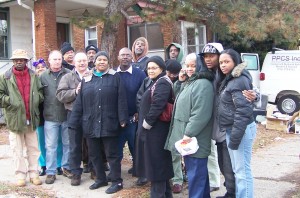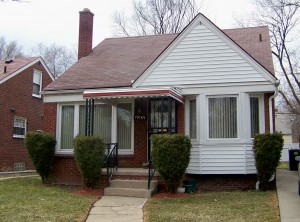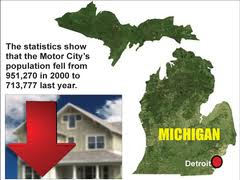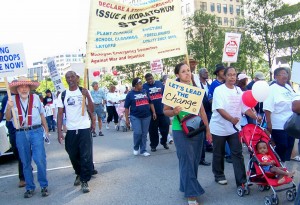By Jerry Goldberg
March 31, 2011
(VOD ed. note: This article relates to Detroit’s census count as recently announced by the federal government. It should be noted that the city government is appealing this count. It should also be noted that if Michigan were to follow the lead of states like New York and New Jersey, and count prisoners in their home districts, Detroit’s population count would be significantly increased. Additionally, the deliberate destruction of the Detroit Public Schools, which are losing 86 percent of their state pupil aid to the banks, has also driven people out of our once great and beloved city.)
Detroit lost 25 percent of its population in the last decade, according to the 2010 U.S. Census. (Detroit News, March 23). Detroit’s population declined from 951,270 in 2000 to 713,777 in 2010.
Detroit, an 85 percent African-American city, experienced the greatest population loss of any U.S. city except New Orleans.
Not one of the many newspaper articles discussing this lost population puts the blame where it belongs — on the major banks, which have leveled neighborhoods throughout Detroit with mass foreclosures driven by racist, predatory lending.
The foreclosure epidemic that has leveled communities throughout Detroit is a direct product of the racist lending practices of every major bank. The Michigan State Housing Development Authority published data noting 62 percent of all mortgage loans to African Americans in metro Detroit in2005-2007 were subprime loans, compared to 28 percent for whites. A huge 87 percent of African-American borrowers in Wayne County, where the city of Detroit is located, were sold subprimeloans in 2006. (Detroit News, Sept. 8, 2007)
A January 2009 report prepared by the City’s Planning and Development Department noted that of 330,000 new mortgages in Detroit from 2004 to 2006, 73 percent were subprime mortgages (mortgages at least 3 percent above the standard interest rate).The report noted that from 2005 to 2009, the city experienced 67,000 bank foreclosures, more than 20 percent of all household mortgages. In addition, there were 4,000 tax foreclosures in the first six months of 2008. The study noted that two-thirds of foreclosed properties were now vacant.

Anthony King (center) was evicted in 2009 from his parental home, where he had lived for 41 years, and cared for his parents; supporters moved him back in but he was eventually forced out; he is featured in Michael Moore's movie "Capitalism: A Love Story."
The foreclosures have continued in the years since this report was published. More than 69,000 homes in the Detroit metro area received delinquency or foreclosure notices in 2009 (foreclosuredeals.com, Feb. 9, 2010) Metro Detroit recorded 43,541 foreclosures in 2010, the third highest number in the U.S. (Detroit News, Jan. 27) Last fall 13,000 tax-foreclosed properties were placed on the auction block. (Michigan Public Radio, Sept. 17).
The banks knew these subprime loans would fail when they made them, but they didn’t care because of the massive profits they made — until the bubble burst, at which time the banks were bailed out by the taxpayers and continue to be bailed out to this day. Most mortgage loans are owned or backed by such federal government entities as Fannie Mae, Freddie Mac and the Department of Housing and Urban Development. The federal government pays the bank the inflated value of the mortgage and then evicts the homeowner.
Stop debt service to the banks

Home on Murray Hill in Detroit in 2009; VOD editor grew up here and home is still well-maintained by its current occupants
Detroit had the lowest foreclosure rate of any metropolitan area in the U.S. in 1996. (Black Commentator, Nov. 22, 2007) An article in Landlord Nation, April 13, 2009, reported that Detroit, a city once known for its high percentage of home ownership for African Americans, now has the lowest ownership rate for single family detached homes out of the 20 largest cities in the U.S. The average sale price of homes in Detroit with HUD-backed mortgages plunged from $46,702 in 2003 to $8,672 in 2008 and $6,035 for the first three months of 2009.
As early as March 2007, the Moratorium Now! Coalition to Stop Foreclosures, Evictions and Utility Shutoffs pointed out to Democratic Gov. Jennifer Granholm that she could declare a state of economic emergency under Michigan law and place a moratorium on foreclosures based on the 1930s Mortgage Moratorium Act, which was upheld by the Michigan and U.S. Supreme Courts.
Granholm explicitly stated, “The banks wouldn’t like it.”
The coalition similarly approached three Detroit mayors — Kwame Kilpatrick, Kenneth Cockrel Jr. and Dave Bing — to declare a state of emergency in Detroit and formally request the imposition of a foreclosure moratorium for the city. Each of these politicians rejected this demand that would have preserved Detroit’s housing and population base.
Today, with the city’s tax base destroyed by the loss of property values caused by the foreclosure epidemic, the same banks that caused this crisis have the audacity to demand huge cutbacks in city services and jobs in order to be paid debt service on loans made to the city, which are continually renegotiated as the tax base declines.
In fact, the banks exercise direct control over large sections of the city budget, with casino tax dollars and state revenue sharing paid to trustees, so the funds go directly to the banks. Up to [86 percent of state per-pupil school aid] is earmarked for debt service to the banks (Ed. note: go to VOD articles, “DPS Katrina” Parts One and Two, at http://voiceofdetroit.net/?p=5584 and http://voiceofdetroit.net/?p=5724 to see actual figures from DPS website.)
Detroit can be rebuilt and repopulated. The city needs a massive jobs program where youth can be trained as carpenters, plumbers and electricians to rebuild the housing stock that has been destroyed by the banks, so that vacant homes can be returned to their rightful owners or turned over to the homeless and unemployed. This jobs program can be paid for by placing a moratorium on debt service to the banks, as well as collecting reparations from the banks for destroying this once great city.
Articles copyright 1995-2011 Workers World. Verbatim copying and distribution of this entire articleis permitted in any medium without royalty provided this notice is preserved.
Workers World, 55 W. 17 St., NY, NY 10011
Email: ww@workers.org
Subscribe wwnews-subscribe@workersworld













Besides the murder of Aiyana Jones, this story is probably the most horrific of all in Detroit.